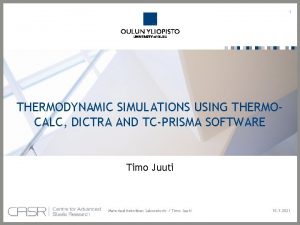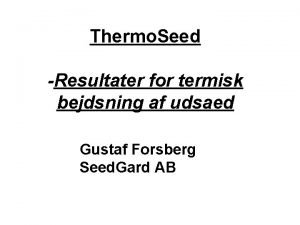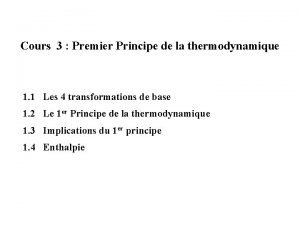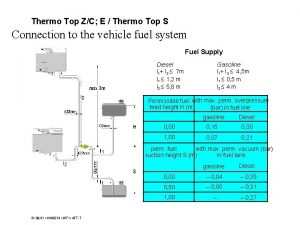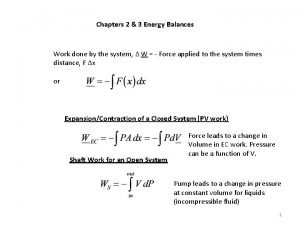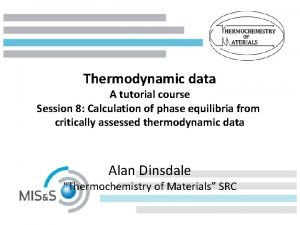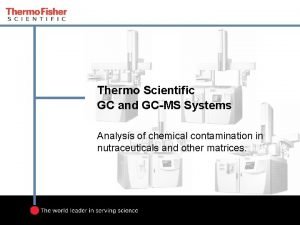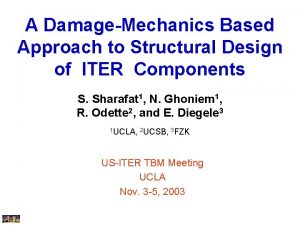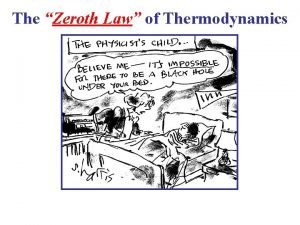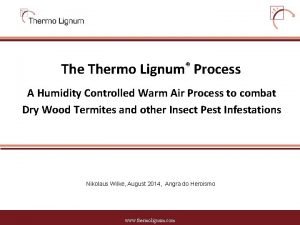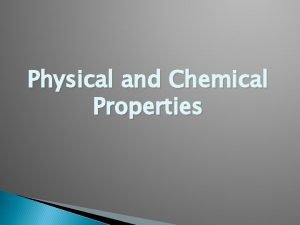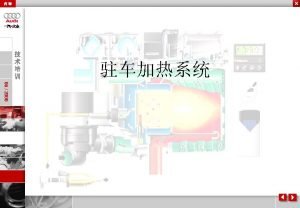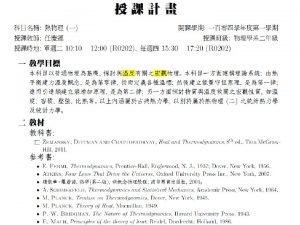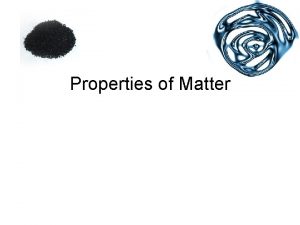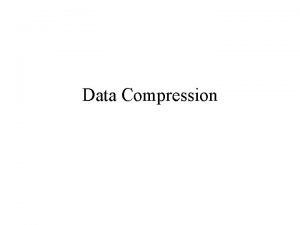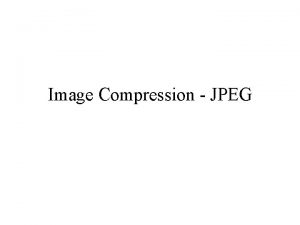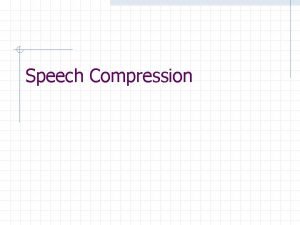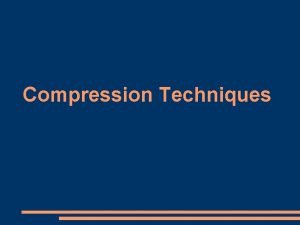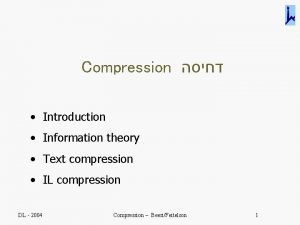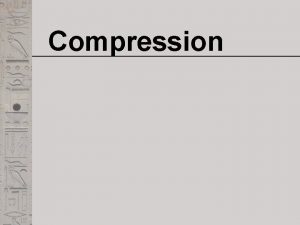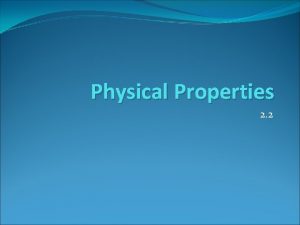Dynamic Compression and Thermo Physical Properties of Some






















- Slides: 22

Dynamic Compression and Thermo - Physical Properties of Some Wood Particles in South Western Nigeria PAPER PRESENTATION BY: ADEKOYA, M. A (MNIP) Department of Physics, Edo University, Iyamho, Edo State, Nigeria. NIGERIAN INSTITUTE OF PHYSICS (NIP) CONFERENCE, 2016 Dynamic Compression and Thermo - Physical Properties of Some Wood Particles in South Western Nigeria by ADEKOYA, M. A is licensed under a Creative Commons Attribution-Non. Commercial-Share. Alike 4. 0 International License.

OUTLINE Introduction Objectives Methodology Instrumentation and Measurement Results /Discussion Conclusion NIGERIAN INSTITUTE OF PHYSICS (NIP) CONFERENCE, 2016

INTRODUCTION ü Wood is a hard fibrous structural tissue found in the stems, roots of trees and other plants. . ü It is an organic material, a natural composite of cellulose fibres (which are strong in tension) embedded in a matrix of lignin which resists compression. ü Despite the many human uses to which various woods are suited, at a fundamental level, wood is a complex biological structure, a composite of many chemistries and cell types acting together to serve the needs of the plant. ü Thermal properties of wood are needed in applications such as fuel conversion, building construction, and other areas of industry NIGERIAN INSTITUTE OF PHYSICS (NIP) CONFERENCE, 2016

LITERATURE REVIEW The use of wooden materials for numerous purposes cannot be over emphasized and various researches had been carried out on these materials at different stages and conditions. Authors Grønli Year Research Results Limitation 1996 Theoretical and Experimental Thermal conductivities for The particle sizes and the Study of the Thermal Degradation Wood at room temperature dynamic compression of Biomass. ranging from 0. 158 – 0. 419 were not considered Wm-1 K-1 and 0. 081 – 0. 209 Wm-1 K-1. Ogunleye and Awogbemi 2007 Determination of Thermo-Physical The samples considered Properties of Eight Varieties of had different thermal Sawdust. conductivity values. Oluyamo and Bello 2014 Particle Sizes and Thermal Insulation Properties of selected Wood Materials for Solar Device Application The particle sizes was not considered Particle sizes consideration Dynamic compression of can be of great importance the material was not in improving the insulation considered properties of wood materials. NIGERIAN INSTITUTE OF PHYSICS (NIP) CONFERENCE, 2016

OBJECTIVES The objectives of this work are to: (a) mould wood shavings into different particle sizes (b) determine thermal properties such as density, thermal conductivity, thermal diffusivity and specific heat capacity of the wood samples in (a) above. (c) examine the dynamic compression i. e. effect of gradual increase in pressure on thermal properties stated in (b) above. NIGERIAN INSTITUTE OF PHYSICS (NIP) CONFERENCE, 2016

METHODOLOGY

METHODOLOGY ü Materials used in this study include two types of wood species of the family Ulmaceae found in the rainforest region of South Western Nigeria. ü The wood samples were collected from different sawmills in Akure South Local Government Area of Ondo State, South Western Nigeria. ü The wood samples were processed to saw-dust at the wood Laboratory of Federal University of Technology, Akure (FUTA). ü The sawdust were screened into different particle sizes; ranging from 300 µm, 600 µm and 850 µm with appropriate mesh and subjected to increased compacting pressures (i. e from 2. 6 – 3. 0 MPa in steps of 0. 1 MPa) using CBR Machine. NIGERIAN INSTITUTE OF PHYSICS (NIP) CONFERENCE, 2016

METHODOLOGY CONT’D ü The thermal conductivity of the samples were determined using modified lee’s disc which consists of three discs A, B and C. ü Samples were moulded into disc form of 4 cm diameter and the thickness ranges from 3 mm to 5 mm, measured using a sensitive digital Vernier Caliper. ü Sample was placed between disc A and B while the heater was position between disc B and C and the set up was placed inside an enclosure to minimize the effect of draught (air resistance). NIGERIAN INSTITUTE OF PHYSICS (NIP) CONFERENCE, 2016

Where, e is given as The density was measured for each of the wood samples using the weighing displacement method while the specific heat capacity �� (k. JKg 1 K-1) was computed using approximately related to temperature t (K) by �� = 0. 1031 +0. 003867 t 3 The thermal diffusivity is given as NIGERIAN INSTITUTE OF PHYSICS (NIP) CONFERENCE, 2016

INSTRUMENTATION AND MEASUREMENT California Bearing Ratio Lee’s Disc Apparatus NIGERIAN INSTITUTE OF PHYSICS (NIP) CONFERENCE, 2016

RESULTS

The results of thermal properties of selected wood product of different particle sizes are recorded in tables 1 -2. Table 1. Thermal Properties of Celtics philippensis Compacting Pressure MPa 2. 6 2. 7 2. 8 2. 9 3. 0 Thermal Conductivity (Wm-1 K-1) 300 µm 600 µm 850 µm Thermal Diffusivity (10 -7 m 2 s-1) 300 µm 600 µm 850 300 600 850 µm µm 300 µm 600 850 µm µm 0. 1335 0. 1234 0. 1201 6. 70 4. 51 4. 99 1. 29 1. 31 1. 30 1. 54 2. 10 1. 86 0. 1431 0. 1334 0. 1232 5. 45 5. 55 4. 60 1. 31 1. 30 2. 00 1. 85 2. 05 0. 1509 0. 1398 0. 1262 6. 81 5. 58 5. 50 1. 29 1. 30 1. 72 1. 93 1. 77 0. 1512 0. 1406 0. 1306 6. 51 5. 70 5. 18 1. 31 1. 30 1. 77 1. 91 1. 93 0. 1534 0. 1435 0. 1351 6. 58 5. 31 1. 33 1. 30 1. 75 1. 68 1. 96

Table 2. Thermal Properties of Celtics zenkeri Compacting Pressure MPa Thermal Conductivity Thermal Diffusivity (Wm-1 K-1) (10 -7 m 2 s-1) 300 µm 600 µm 850 µm 2. 6 0. 123 5 0. 1129 0. 1012 0. 131 4 0. 1182 0. 1123 0. 134 8 0. 1234 0. 1151 0. 141 0 0. 1315 0. 1188 2. 7 2. 8 2. 9 300 µm 7. 00 7. 32 6. 60 7. 00 600 µm 5. 20 5. 36 5. 23 5. 33 850 µm 300 600 µm µm 850 µm 300 µm 600 µm 850 µm 4. 70 1. 3 0 1. 29 1. 30 1. 37 1. 68 1. 66 5. 23 1. 3 1 1. 30 1. 29 1. 38 1. 70 1. 67 5. 05 1. 3 0 1. 31 1. 58 1. 82 1. 74 5. 08 1. 2 9 1. 28 1. 30 1. 56 1. 93 1. 80

Thermal Conductivity (Wm-1 K-1) 0. 16 0. 15 0. 14 300µm 0. 13 600µm 0. 12 850µm 0. 11 0. 1 2. 6 2. 7 2. 8 2. 9 Compacting Pressure (MPa) 3 Fig. 1: Graph of Thermal Conductivity as a function of 0. 15 0. 14 0. 13 300µm 0. 12 600µm 0. 11 850µm 0. 1 2. 6 2. 7 2. 8 2. 9 Compacting Pressure (MPa) 3 Fig. 2: Graph of Thermal Conductivity as a function of Compacting ) Compacting Pressure for Celtis phillipensis ( Ita funfun Pressure for Celtis zenkeri ( Ita pupa) 1340 1330 1320 1310 1300 300µm 1290 600µm 1280 850µm 1270 1260 2. 6 2. 7 2. 8 2. 9 Compacting Pressure (MPa) 3 Fig. 3: Graph of Specific Heat Capacity as a function of Compacting Pressure for Celtis phillipensis ( Ita funfun) Specific Heat Capacity (JKg-1 K-1) 1315 1310 1305 1300 1295 1290 1285 1280 1275 1270 1265 300µm 600µm 850µm 2. 6 2. 7 2. 8 2. 9 Compacting Pressure (MPa) 3 Fig. 4: Graph of Specific Heat Capacity as a function of Compacting Pressure for Celtis zenkeri ( Ita pupa)

2. 00 E-07 1. 90 E-07 300µm 600µm 1. 70 E-07 850µm 1. 50 E-07 2. 6 2. 7 2. 8 2. 9 Compacting Pressure (MPa) 3 Thermal Diffusivity (m 2 s -1) 2. 10 E-07 1. 80 E-07 1. 60 E-07 1. 40 E-07 300µm 600µm 1. 20 E-07 850µm 1. 00 E-07 2. 6 2. 7 2. 8 2. 9 3 Compacting Pressure (MPa) Fig. 5: Graph of Thermal Diffusivityas a function of Compacting Pressure for Celtis philippensis ( Ita funfun) Fig. 6: Graph of Thermal Diffusivityas a function of Compacting Pressure for Celtis zenkeri ( Ita Pupa)

Figure 1– 2 shows that thermal conductivities increase with compacting pressure. This could be due to decrease in porosity as the compacting pressure increases. As sample particle sizes decreases, thermal conductivities increase. This could be due to reduction in intermolecular distance between the grains in the wood materials as the particle sizes decrease. This is being expected as the particle sizes increases, the porosity of the materials also increases leading to decrease in conductivity The variations of the various specific heat capacities of the selected wood samples as a function of compacting pressure are displayed in Figure 3 and 4. It was observed that, the specific heat capacity has no defined trend with the compacting pressure for all the wood samples. The values of the specific heat capacities only fluctuate between minimum and maximum values within the range of compacting pressure. NIGERIAN INSTITUTE OF PHYSICS (NIP) CONFERENCE, 2016

Figures 5– 6 show the variations of thermal diffusivities of the selected wood samples. The values of thermal diffusivity changes gradually as the compacting pressure increases except at 2. 9 MPa compacting pressure which increases as the particle sizes increase. Evidence of slight increase in thermal diffusivities of the wood samples was noticed as particle size increases from 300 µm to 600 µm but decreases monotonically at 850 µm for Celtis zenkeri. NIGERIAN INSTITUTE OF PHYSICS (NIP) CONFERENCE, 2016

APPLICATION Table 3 : Thermal Conductivity of Common Insulator Materials S/N 1 2 3 4 5 6 7 8 9 Material Brick (Insulating) Asbestos(Loosely packed) Diatomite Polyisoprene Natural Rubber Phenol-Formaldehyde (Moulding Compound) Asbestos( Cement) Chlorinated Poly-ether Breeze (Block) Polystyrene Thermal Conductivity (Wm-1 K-1 ) 0. 15 0. 12 0. 14 0. 15 0. 14 0. 13 0. 10 – 0. 20 0. 13

CONCLUSION

CONCLUSION v The effects of Dynamic Compression and Thermo - Physical Properties of Some Wood Particles in South Western Nigeria were investigated. It was established in the research that thermal conductivity of wood materials used in the study falls between 0. 1012 – 0. 1534 Wm-1 K-1. v The thermal conductivities values for the wood samples were found to conform with the general range of conductivity for wood materials. The thermal conductivity of wood samples increase with increase in compacting pressure for all wood samples due to a decrease in porosity. As sample particle sizes decreases, thermal conductivities, increases which is attributed to reduction in intermolecular distance between the grains in the wood materials as the particle sizes decreases. v The specific heat capacity for the wood samples has no definite trend of variation with the compacting pressure.

CONCLUSION CONT’D v In general, the range of values of thermal properties of the materials in the study fall within the values of some commonly used in building materials. v The result in the study revealed that dynamic compression affects thermal properties of the wood samples. Hence, the effects of pressure on wood utilization need to be considered in their various mode of applications. NIGERIAN INSTITUTE OF PHYSICS (NIP) CONFERENCE, 2016

Thank you for listening Dynamic Compression and Thermo - Physical Properties of Some Wood Particles in South Western Nigeria by ADEKOYA, M. A is licensed under a Creative Commons Attribution-Non. Commercial-Share. Alike 4. 0 International License.
 Physical property and chemical property
Physical property and chemical property Contact vs noncontact forces
Contact vs noncontact forces Some trust in chariots and some in horses song
Some trust in chariots and some in horses song Thermo prefix
Thermo prefix Thermo solver
Thermo solver Thermo haake rheometer
Thermo haake rheometer Ascoli's thermo precipitation test
Ascoli's thermo precipitation test Thermo fisher core values
Thermo fisher core values Thermo chromeleon
Thermo chromeleon Tropo strato meso thermo exo
Tropo strato meso thermo exo Thermo king candiag software
Thermo king candiag software Thermocalc examples
Thermocalc examples Thermo fisher scientific vision statement
Thermo fisher scientific vision statement Thermo seed
Thermo seed Premier principe de la thermodynamique
Premier principe de la thermodynamique Thermo top z/c
Thermo top z/c Thermo
Thermo Ttrs
Ttrs Thermo
Thermo Thermo asri makmur
Thermo asri makmur Thermo-mechanical fatigue
Thermo-mechanical fatigue Zeroth law of thermodynamics
Zeroth law of thermodynamics Keylwerth diagramm
Keylwerth diagramm











